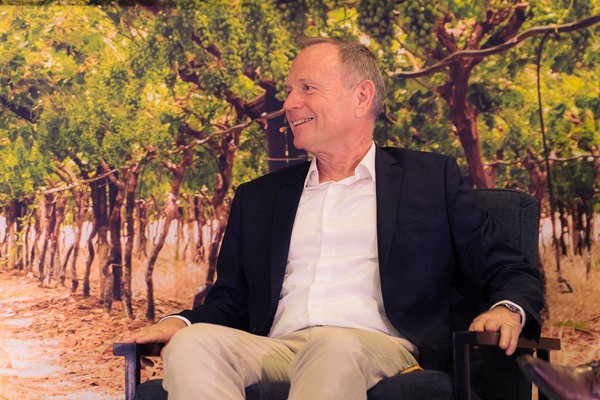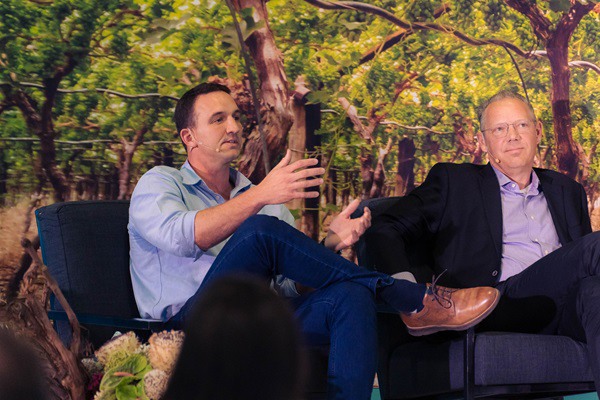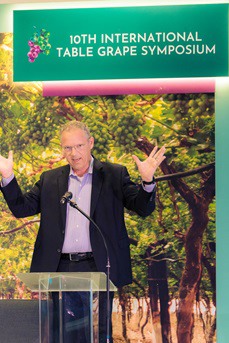Symposium attendees were keen to hear from Hans-Ole Madsen from Philippine-based International Container Terminal Services, Inc which is the preferred bidder to operate pier 2 of the Durban Container Terminal (DCT) over the next 25 years.

Hans-Ole Madsen from Philippine-based International Container Terminal Services, Inc (photos: Bradley Urion)
The CEO of the South African Table Grape industry AJ Griessel remarked that the industry was out of homemade solutions and very concerned at the state of equipment but also encouraged by newly-appointed CEO Michelle Phillips who, Griessel observed, understands the company and the industry.
Hans-Ole Madsen started off by lauding South Africa’s decision to finally follow the global trend to privatise port operations. They hope to be operational at DCT within the next three to four months. “Hopefully they’ll invite us to Cape Town also to do it there,” he quipped.
“Despite everything, South Africa actually has very good IT systems, but a computer can’t solve everything.” He flagged cyber attacks as a risk, while at the same time sharing data more widely with role-players.
Maintenance & repair of DCT equipment goes 75% of the way
How long can ICTS take to fix Durban pier2? “The biggest problem is that the equipment doesn’t work. The biggest thing is to go through all the equipment feed, maintain and repair what’s on the ground at the moment. That will take you 75% of the way. That will take anywhere from six to twelve months, depending on the availability of spare parts and so on.”
He continued: “After that, or simultaneously, you’ll start looking at processes. In my opinion you have fantastic port assets, the footprint is nice, everything is nice, so why doesn’t it work? Well, number one, the machines don’t work and number two is that everyone works very slowly.”
Attendees laughed in agreement at his frank assessment. He added: “If everyone could work a little bit faster it would be pretty good. I’ll pay people incentives to work faster.”
Madsen also had a little admonition for the South African industry which dislikes the new truck booking system at Port Elizabeth. “We operate a big port in the Philippines where we handle three million containers per year. This is only possible through a truck appointment system where you pay more for a peak slot. We’re trying to even the number over 24 hours a day.”
Through making the truck booking system work, the local industry can play a small role in improving what is clearly a “dire” situation. “It’s urgent and it hurts you the most.”
Lifting the conversation to HQ level
South Africa almost feels like home to Thomas Eskesen: his eponymous advisory has been helping the South Africa fruit industry see through supply chain issues on logistics.

AJ Griessel, SATGI CEO, and Thomas Eskesen of Eskesen Advisory
Eskesen’s first observation of the South African fruit industry, he said, was that the industry was super-fragmented between commodities.
“South Africa in general has completely missed in the boat in terms of taking logistics seriously. The platform we have now created is exciting because we are now talking across fruit fraternities and we have lifted the conversation from a local conversation to a headquarter conversation.”
Like other attendees, Eskesen is also in Dubai for COP28 today where a cold chain alliance looking at food waste and temperature management will be launched.
South Africa is a great place to be from a logistics standpoint, Eseken remarked, however: “When you’re shipping grapes from Argentina or Chile or Peru you definitely have a choice of five, six very legitimate shipping lines. Here it’s principally a two-player market [Maersk & MSC]. Unless we change that, South Africa will probably be lagging behind rest of the world for many years.”
Chartering an old reefer vessel will no longer cut it: most vessels are over than 30 years, many will be taxed or scrapped in line with new environmental laws. It might be sufficient to place South African grapes in the UK ahead of Christmas, “but it won’t save us at the end of the day”, he remarked.
In future a two tier-system of ‘green’ vessels to progressive ports and fuel guzzlers to the rest of the world could develop.
“Right now the biggest bottleneck is the fuel. Maersk is investing lot into e-methanol but there’s not enough to supply ships. Ammonia seems to be a better play but there are safety issues. We really need global legislation on this,” Eskesen observed.
Shortage of fresh product The 2% drop in refrigerated cargo has come to no surprise to anyone with an ear on the farm.
The 2% drop in refrigerated cargo has come to no surprise to anyone with an ear on the farm.
“Retailers who are still beating up their suppliers: guys, I tell them, be careful what you’re doing: there’s not enough product for everybody,” Eskesen (right) said.
Russia remains a pain point.
“The good news is we’re largely going back to a more normal situation on shipping costs,” he said, but price inflation on fuel and labour has hit shipping lines hard.
Shipping lines have quickly gone from making “tonnes of money” to being in the red by next year, Eskesen predicts.
Placing many thousands of floating cold stores across the world for the different seasons – often with contracts concluded at the last minute – is complex, but at least the world is “swimming in reefer boxes”.
Shipping line profits – almost a billion dollars per week for some last year – have been invested into smart containers which he considers an important way of getting to the bottom of food waste.
“Do you really want a port in downtown Cape Town? Maybe move it to Saldanha Bay and get the traffic away from city. You have the most beautiful waterfront in the world – should the port be there?” Eskesen put to the audience.
